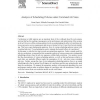Free Online Productivity Tools
i2Speak
i2Symbol
i2OCR
iTex2Img
iWeb2Print
iWeb2Shot
i2Type
iPdf2Split
iPdf2Merge
i2Bopomofo
i2Arabic
i2Style
i2Image
i2PDF
iLatex2Rtf
Sci2ools
PE
2010
Springer
2010
Springer
Analysis of scheduling policies under correlated job sizes
Correlations in traffic patterns are an important facet of the workloads faced by real systems, and one that has far-reaching consequences on the performance and optimization of the systems involved. However, all the existing analytical work on understanding the effect of correlations between successive service requirements (job sizes) is limited to First-Come-First-Served scheduling. This leaves open fundamental questions: How do various scheduling policies interact with correlated job sizes? Can scheduling be used to mitigate the harmful effects of correlations? In this paper we take the first step towards answering these questions. Under a simple model for job size correlations, we present the first asymptotic analysis of various common size-independent scheduling policies when the job size sequence exhibits high correlation. Our analysis reveals that the characteristics of various scheduling policies, as well as their performance relative to each other, are markedly different...
| Added | 29 Jan 2011 |
| Updated | 29 Jan 2011 |
| Type | Journal |
| Year | 2010 |
| Where | PE |
| Authors | Varun Gupta, Michelle Burroughs, Mor Harchol-Balter |
Comments (0)

